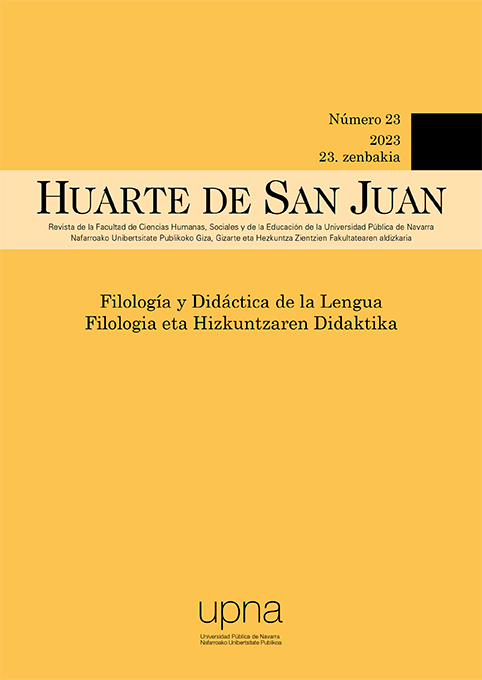Metalinguistic reflection and grammatical systematization of secondary school students in a didactic grammar sequence on habituality
DOI:
https://doi.org/10.48035/rhsj-fd.23.3Keywords:
didactic grammar sequences, metalinguistic awareness, interlinguistic contrast, grammar instruction and use, language learningAbstract
This study reports the results of the analysis of two groups of 1st of ESO students’ textual productions to examine to what extent metalinguistic awareness can improve language learning and written expression. The methodology we have used is qualitative and responds to action research. The productions analysed are of two types: drafts, revisions, and letters, in which the students use the grammatical elements under study; and summary documents and reports, in which they reflect on the grammatical elements they have used. The conclusions obtained enable us to affirm that the summary documents and the reports promote metalinguistic awareness and that understanding how language works is not always related to a mastery of metalanguage. These results also indicate that the contrast between languages favours their learning and that teachers play a fundamental role in the development of learners’ metalinguistic competence.
Downloads
References
Abad, V., y Rodríguez-Gonzalo, C. (2023). Cómo abordar la reflexión gramatical en el aula. Textos de Didáctica de la Lengua y la Literatura, 100, 33-38.
Camps, A. (2006). Secuencias didácticas para aprender gramática (SDG). En Camps, A., Zayas, F. (Coords.), Secuencias didácticas para aprender gramática (31-48). Graó.
Camps, A. (Coord.), Guasch, O., Milián; M., y Ribas, T. (2005). Bases per a l’ensenyament de la gramàtica. Biblioteca d’Articles, 146. Graó.
Doughty, C., y Williams, J. (1998). Focus on form in Classroom Second Language Acquisition. Cambridge University Press.
Durán, C. (2010a). Les competències i l’ensenyament de la gramàtica. Articles Didàctica de la Llengua i la Literatura, 51, 36-50.
Durán, C. (2010b). Parlem de l’adverbi. Els conceptes gramaticals dels alumnes de l’ESO. Articles Didàctica de la Llengua i la Literatura, 52, 91-109.
Fontich, X. (2011). Parlar i escriure per aprendre gramàtica a secundària. Articles Didàctica de la Llengua i la Literatura, 52, 112-122.
Fontich, X., García Folgado, M. J., y Rodríguez-Gonzalo, C. (Coords.). (2022). El rol de l’ensenyament gramatical en l’aprenentatge de llengües: pràctiques reflexives, tasques comunicatives i material d’intervenció. Caplletra 73, 149-158. https://doi.org/10.7203/caplletra.73.24636
Garcia Vidal, P. (2018). Com s’aprenen les llengües en Secundària. Perifèric.
Guasch. O. (2011). Plurilingüisme i formació lingüística dels escolars. En O. Guasch (Coord.), El tractament integrat de les llengües (13-28). Graó.
Milián, M. (2023). Leer y escribir. Algunas consideraciones sobre el discurso y el conocimiento lingüístico. Articles Didàctica de la Llengua i la Literatura, 99, 22-30.
Milián, M. (2012). El model de seqüència didàctica vint anys després. Un model vàlid per ensenyar a aprendre i per aprendre a ensenyar. Articles Didàctica de la Llengua i la Literatura, 57, 8-21.
Ribas, T., Rodríguez-Gonzalo, C., y Durán, C. (2020). El aprendizaje de la escritura de textos de opinión en alumnos de Primaria: análisis de la actividad metalingüística, de los conceptos sobre la escritura y de los productos finales. Indagatio Didactica, 12(2), 33-54. https://doi.org/10.34624/id.v12i2.17436
Rodríguez Gonzalo, C. (2009). L’avaluació del saber gramatical de l’alumnat en una activitat de revisió de l’ús dels temps vebals del passat. Articles Didàctica de la Llengua i la Literatura, 47, 26-50.
Rodríguez Gonzalo, C. (2012). La enseñanza de la gramática: las relaciones entre la reflexión y el uso lingüístico. Revista Iberoamericana de Educación, 59, 87-118. https://doi.org/10.35362/rie590458
Rodríguez-Gonzalo, C. (2020). Evidències per millorar la competència en comunicación lingüística. Evidències científiques per millorar la pràctica docent. Dossier 5. Graó.
Rodríguez-Gonzalo, C. (2021). Una gramática escolar interlingüística. Hacia una enseñanza reflexiva de las lenguas en contextos multilingües. Huarte de San Juan. Filología y didáctica de la lengua, 21, 33-55. https://doi.org/10.48035/rhsjfd.21.2
Rodríguez-Gonzalo, C. (2022a). Situaciones de aprendizaje para la reflexión interlingüística. Textos de Didàctica de la Lengua y la Literatura, 97, 41-46.
Rodríguez-Gonzalo (2022b). La enseñanza reflexiva de las lenguas en contextos multilingües (Egramint). Tavira. Revista Electrónica de Formación de Profesorado en Comunicación Lingüística y Literaria, 27, 1-14. https://doi.org/10.25267/Tavira.2022.i27.1104
Ruiz Bikandi, U. (2008). La reflexión metalingüística desde varias lenguas. Textos de Didáctica de la Lengua y la Literatura, 47, 33-45.
Sánchez, S., Santolària, A., y Casas, M. (2022). Alfabetización inicial, contenidos gramaticales y análisis curricular en contextos plurilingües. En J. M. Rodríguez (Coord.), Lengua y literatura: didáctica y nuevas tecnologías (13-24). Dykinson.
Vigotski, L. S. (1995). Pensamiento y lenguaje. Fausto. https://abacoenred.com/wp-content/uploads/2015/10/Pensamiento-y-Lenguaje-Vigotsky-Lev.pdf
Wood, D., Bruner, J., y Ross, G. (1976). The role of tutoring in problem solving. Journal of child psychology and psychiatry, 17, 89-100. https://doi.org/10.1111/j.1469-7610.1976.tb00381.x
Downloads
Published
How to Cite
Issue
Section
License
Copyright (c) 2024 Teresa Llamazares Prieto, Pilar Garcia Vidal

This work is licensed under a Creative Commons Attribution-NonCommercial-NoDerivatives 4.0 International License.
All articles are published under a Creative Commons (BY-NC-ND 4.0) license. Each article will be assigned a DOI.
Authors retain copyright of their work and grant the journal the right to the first publication. Authors can sign additional agreements to non-exclusive distribution of the published version of the article (for example, in an institutional repository) as long as appropriate attribution to the original publication is provided. Articles can be uploaded to institutional repositories immediately after publication.
Electronic distribution of the articles (for example, academic social networks or personal webpages) is allowed and encouraged.
The journal reserves the right to publicise the work in social networks and other electronic means.







